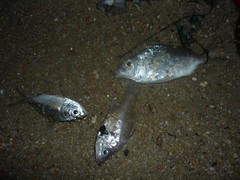
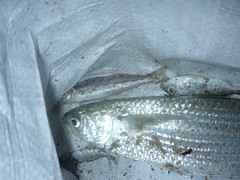

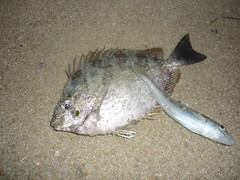
Among the most obvious inhabitants that I found living in the murky swimming lagoons of Siloso Beach were various fishes. And although most of them refused to pose for photographs, I did manage to glimpse some of them for long enough to identify them tentatively.
The gobies were well-represented, with small groups of ornate lagoon-gobies (Istigobius ornatus) and shadow goby (Acentrogobius nebulosus) hiding on the seabed close to the rocks, and small mudskippers (Periophthalmus sp.) along the shoreline and amongst the rocks.
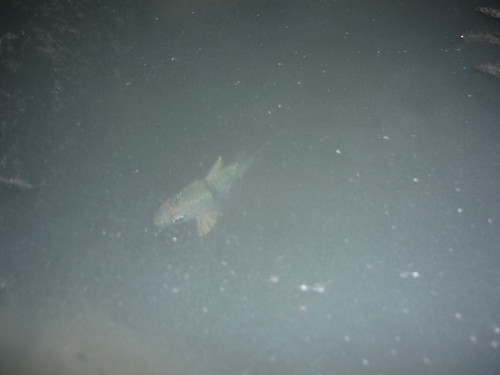
The rocks were a hiding place for more than just gobies, and I spotted a couple of orbicular cardinalfish (Sphaeramia orbicularis).
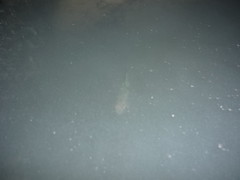

I tried my best to stay still, and took these photos before they vanished. The murky water was a real challenge.
Close to shore, my movement disturbed schools of small fish, most of which darted away the moment the light from my torch fell upon them. Some of those that I recognised include Kops' glass perchlet (Ambassis kopsii), and juvenile deepbody mojarra (Gerres abbreviatus) and slender mojarra (Gerres oyena). I also managed to encounter a few tropical silversides (Atherinomorus duodecimalis), though not in large numbers like on other shores. In the deeper parts of the lagoon, occasional loud splashes hinted at the presence of much larger fish.
Among the sargassum (Sargassum sp.) that grows around the bridge that connects this islet to Siloso Beach, I made another exciting discovery.


Two baby silver moonies (Monodactylus argenteus), only the size of my thumbnail. Aren't they cute?
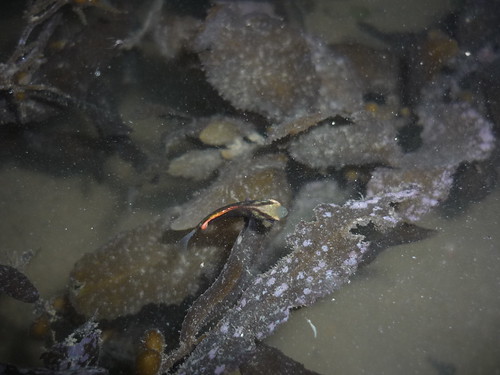
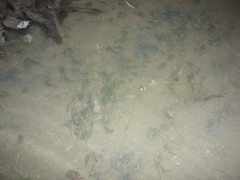
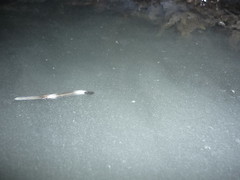
There were more schools of unidentifiable tiny fish hanging around the bridge and amongst the seaweed. Above a small bed of spoon seagrass (Halophila ovalis), I found a school of chequered cardinalfish (Apogon margaritophorus), which proved impossible to photograph, as well as young individuals of two different species of halfbeak (F. Hemirhamphidae). The identity of these two species is not known, but for now, Ria has labeled them as the 'twig-like halfbeak' and the 'broad-nose halfbeak'.
Two Bangladeshis crossed the bridge, carrying a large bag. One of them took out a cast net and waited at the water's edge. There was a splash, and as if on cue, he deftly threw the net into the water, waited for it to sink to the bottom, then slowly hauled it to shore. As the two men dragged the net up onto the beach, there were sudden tiny flashes of blue light, made by the tiny crustaceans known as ostracods or mussel shrimp.
I wasn't surprised that they managed to catch fish, but I was really surprised at the size of the fish they caught!
Here's some of the fish that they bagged.
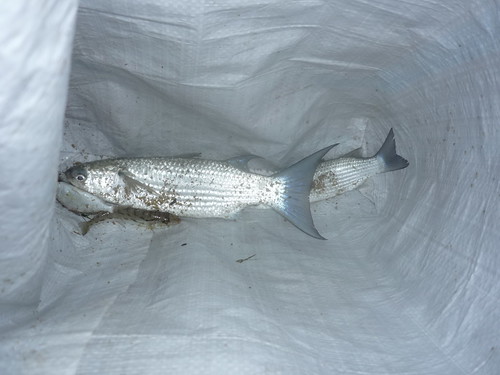
Two large mullets (F. Mugilidae). The larger one was longer than my foot!
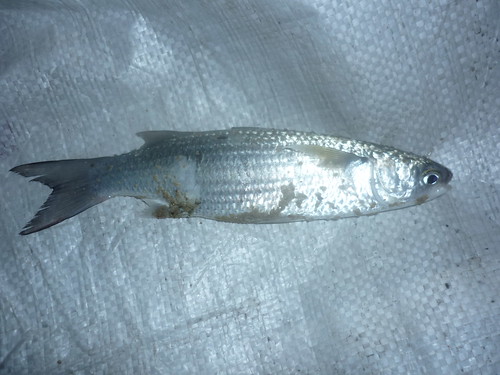
Here's a closer look at the smaller mullet. This might be the greenback mullet (Liza subviridis).
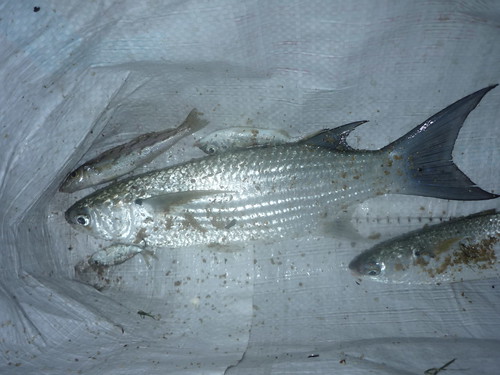
After looking through my photographs, I now want to kick myself for not having taken any detailed shots of the larger mullet. Based on the the shape of the dorsal and caudal fins, it seems that it's a different species of mullet from the smaller one. I have no idea which species the larger mullet might possibly belong to.

I think this is a slender mojarra.


Some sort of whiting (F. Sillaginidae). Sillago aeolus, perhaps?
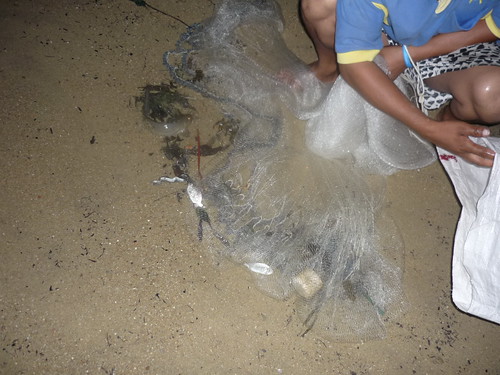
The net was thrown again, and more fish were brought in.
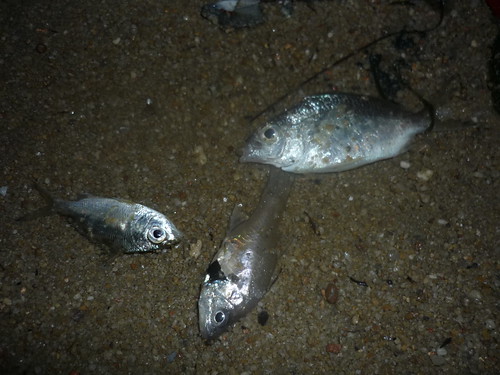
My tentative identifications for these 3 fish are: slender mojarra (left), Kops' glass perchlet (centre), and deepbody mojarra (right).
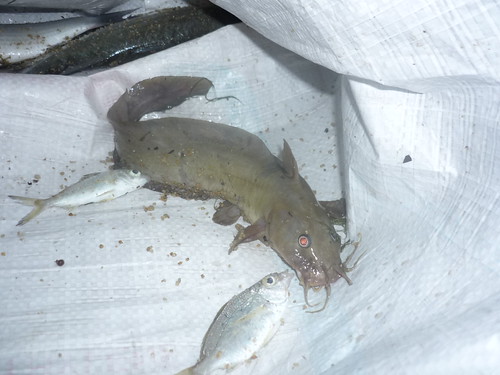
A large catfish, the size of my foot! Sorry for using my foot as a point of reference so often, it's the easiest thing to use for comparison (My foot's about 26cm long, by the way).

It's obviously an eeltail catfish (F. Plotosidae). But it definitely doesn't quite look like the two species of eeltail catfish I've seen on many visits to our shores, the black eeltail catfish (Plotosus canius) and the striped eeltail catfish (Plotosus lineatus).
Could it be a white-lipped eeltail catfish (Paraplotosus albilabris)?
One of the guys told me that this sort of catfish is very expensive back home in Bangladesh. He said that they come here to fish once in a while, whenever they're able to take a break from work. Sometimes the catch is good, and they manage to net a lot of big fish.
The net was cast for a third and final time.
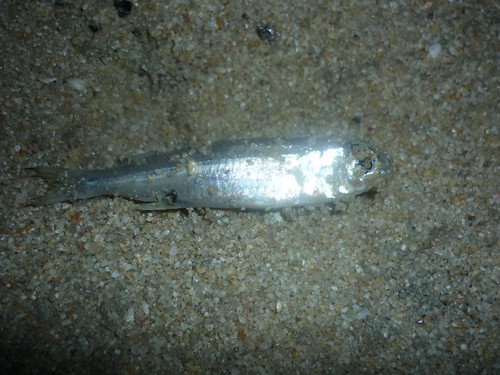
I have no idea what species of fish this is. If I had to hazard a guess, it would be a member of the Clupeiformes, a group of fishes that includes herrings and anchovies. Based on my copy of A Guide to Common Marine Fishes of Singapore, this could possibly be Dussumier's thryssa (Thryssa dussumieri), which belongs to the anchovy family.

A much larger deepbody mojarra.
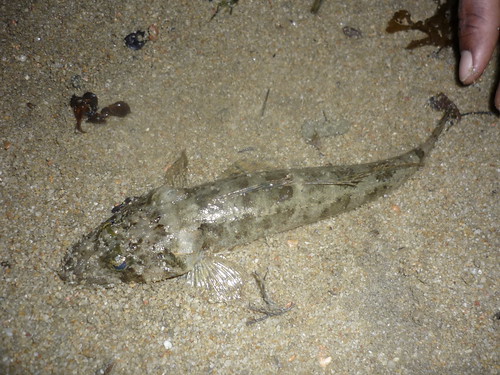
A large fringe-eyed flathead (Cymbacephalus nematophthalmus). Once again, it's nearly the size of my foot.

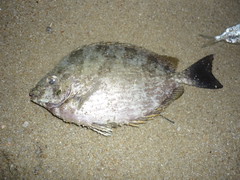
Two good-sized rabbitfish (F. Siganidae). Is this the streaked rabbitfish (Siganus javus)?
After this, the men left with their catch. The one whom I spoke to earlier on shook his head and commented that today's catch wasn't very good compared to previous visits. I'd like to see how much they catch on a good day.
As far as I know, fishing on Sentosa is illegal. But the opportunism of these two men provided a chance to document some of the fish that would otherwise be virtually impossible for me to find or photograph. Also, it shows how these artificial lagoons do support a rich variety of marine life, including fish fit for consumption.
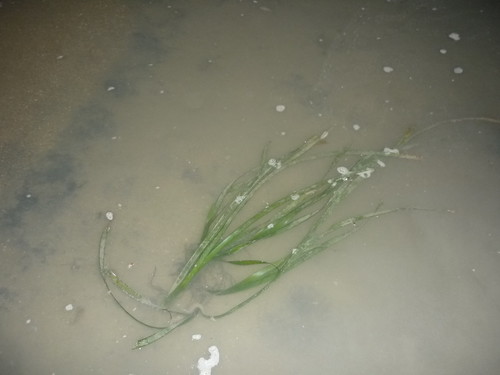
The most exciting find of the night occurred when I came upon this lone tape seagrass (Enhalus acoroides).
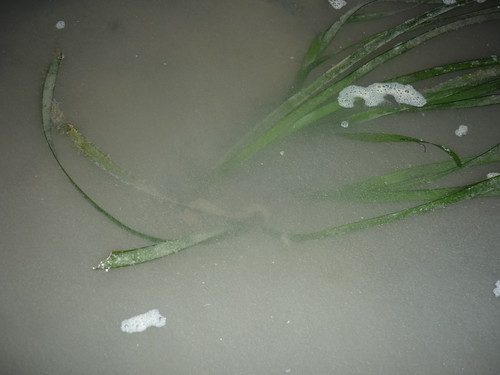
As I took a closer look, I thought I saw something brown clinging to one of the leaves.

Peering into the murky water, my heart skipped a beat as the unmistakable shape of a seahorse came into view.
At that moment, all I could say was "Oh my God, it's a seahorse!"
Who would have thought that one could find a common seahorse (Hippocampus kuda) in an artificial lagoon at Siloso Beach?
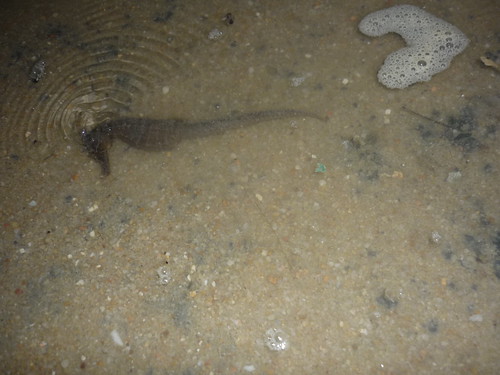
The amount of sediment in the water was really hampering my attempts to take a decent photo of this amazing find. So I gently disentangled its prehensile tail from the seagrass, and brought it to shore. Naturally, it was very unhappy at this, and turned from pale brown to black.

This is the first time I've seen a seahorse on a southern shore. Feeling bad for subjecting it to such stress, and for not having brought a container along so that the seahorse could remain in water while I took the photos I needed, I quickly returned it to the seagrass.
Finding a seahorse definitely more than made up for the lack of common sea stars (Archaster typicus) tonight. And I certainly discovered that these murky waters, although seemingly lifeless, do contain plenty of surprises. My interest in finding out more about this special shore has certainly been piqued.
Does anyone want to attempt a muck dive over here? Who knows what lurks in the deeper parts of the lagoon?
The next time I visit this shore, I'm definitely going to need the following:
i) Containers. I'm not a fan of taking photos of marine animals in plastic containers, since I greatly prefer showing them in their natural environment. But given the murky water, and the fact that it's too easy for various creatures to swim away into deeper water and vanish, the use of containers will be a great aid.
ii) Nets. A few small aquarium nets, which would help me spend more time studying fish closely, instead of just seeing them shoot off into the depths before I can even react to their presence. Used in conjunction with a few small plastic containers, I don't have to worry so much about all the sediment in the water when I'm trying to take photos.
iii) Snorkel. I don't know if I'll be able to see anything though.
It's great to see that despite the heavy use of this shore, there's really quite a wide diversity of fish living in these waters. I really want to go back and explore this area more often, as well as check out the other islets that will require a bit of swimming to reach. Maybe an acquaintance of mine wasn't exaggerating when he said he saw a large barramundi (Lates calcarifer) swim past him at Palawan Beach...
This is part 2 of a 2-part series on a trip to Siloso Beach on 16th December, 2008.
Part 1: Siloso Surprises
Part 2: Fishy business on Siloso (this post)